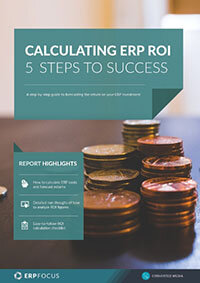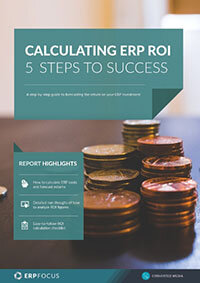The value of ERP ROI as a project metric
The ERP system you use to help manage your business must earn money for your organization. The ERP system that most organizations select must earn an awful lot of money. If you cannot reasonably predict earnings from your ERP that sufficiently outweigh your system costs, you probably should look for another place to spend your money that will provide a financial return.
If you cannot reasonably predict earnings from your ERP that sufficiently outweigh your system costs, you probably should look for another place to spend your money
Return on Investment (ROI) is easily the most common method used in business to measure that return and be able to compare it with other potential investments. ROI is a simple metric; It is easily calculated by adding up the expected return from an ERP system and then subtracting the expected costs of the ERP. Divide the result by the same expected cost and the quotient is your ERP ROI.
This technique for calculating ERP ROI works for any investment. Generally the larger the quotient, the better the investment ranks among investment choices.
The flexible nature of ERP ROI
ROI can be a flexible metric for many ERP projects. This is an advantage as different people from different disciplines might define the costs or the returns for an ERP project in their own way. But this can also be a disadvantage. The ERP ROI defined in one way may not be relevant to a return with a different basis calculated by another department. The importance of keeping the calculations consistent cannot be overstated.
Recommended Reading: How to calculate ERP ROI - Make progress towards using ROI as a project metric
It is also worth noting, time is not a factor in calculating return on investment. Compare two potential ERP investments, each with a cost of $75,000 and an expected return of $100,000. Both show a 33% ROI and seem to be equal possible investments. Dig a little deeper and we might learn that the entire cost on one project must be paid tomorrow and the return won’t be seen until next year. The other has costs spread over the next six months and begins to show gains after the third month with the entire gain expected by the end of the year. Clearly the second choice appears better now.
Temporal factors in an ERP ROI
We can add a simple measure of time to our ERP ROI calculation using payback period which looks to see how many months it takes to recapture ERP costs. Another more sophisticated metric that captures the value of time is internal rate of return. Costs in the next month are more expensive than costs in a future period. Gains that begin sooner are more valuable than a gain later. IRR provides a percentage value that looks like the quotient in ERP ROI.
Finally, it should be noted that a further potential shortfall in the use of ROI is risk. We will be looking into the future for most of the costs and probably all of the returns. How certain are you of your ERP project costs? The answer to that question probably depends heavily on the extent of your ERP budget planning activities.
Free white paper

Calculating ERP ROI: 5 steps to success
Calculate your new ERP's financial benefits with this comprehensive guide

Featured white papers
Related articles
-

28 cost elements to include in your ERP TCO calculation
With differing definitions and more hidden costs than you can shake a stick at, ERP TCO can be a ...
-

CMMC Compliance: What Aerospace and Defense Manufacturers Need to Know
Key insights on CMMC compliance, deadlines, and securing DoD contracts with CMMC 2.0 certificatio...
-

Funding an ERP: how and why?
What funding is available for ERP including loans and grants


